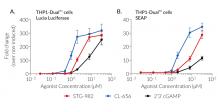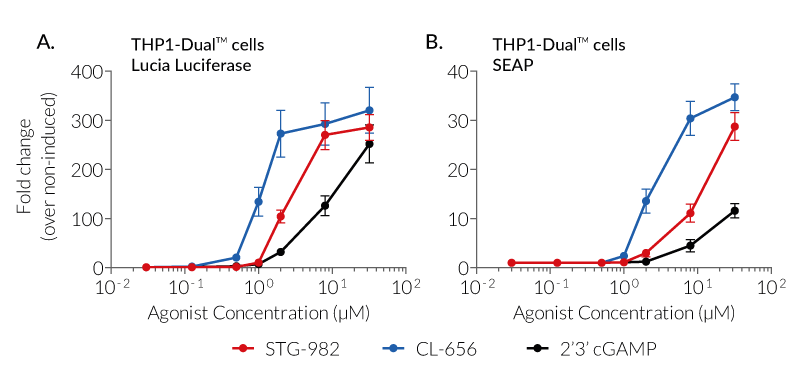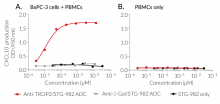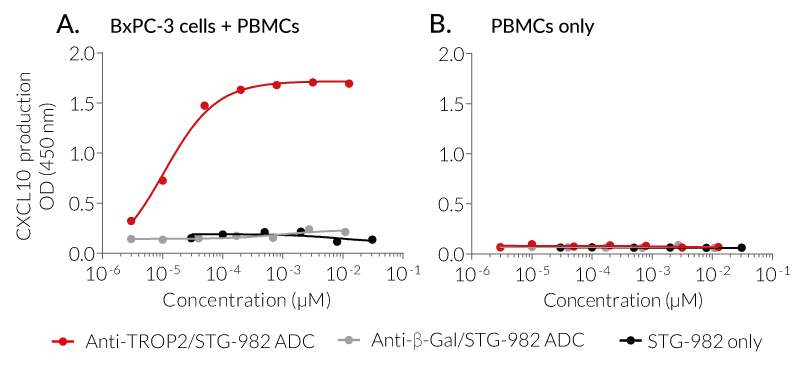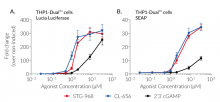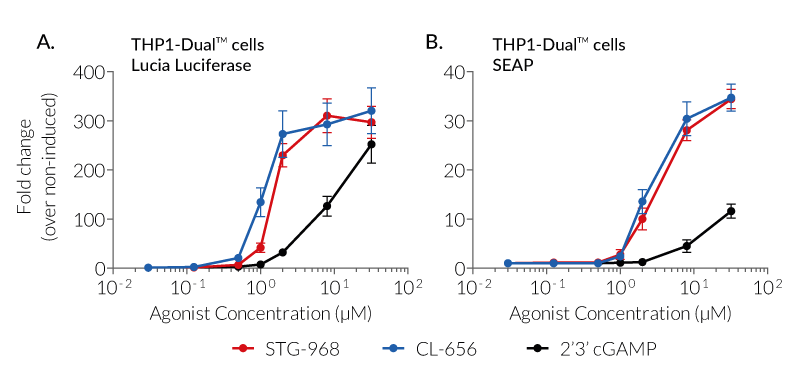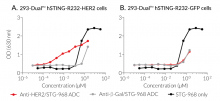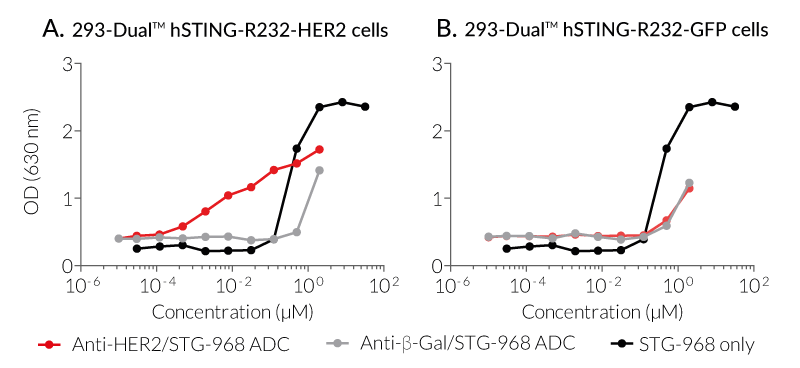Conjugatable STING Ligands
| Product | Unit size | Cat. code | Docs. | Qty. | Price | |
|---|---|---|---|---|---|---|
|
STG-982 STING agonist with a maleimide group - VacciGrade™ |
Show product |
250 µg 1 mg (4 x 250 µg) |
vac-stg982
|
|
||
|
STG-968 STING agonist with an azido group - VacciGrade™ |
Show product |
250 µg 1 mg (4 x 250 µg) |
vac-stg968
|
|
STING agonists for bioconjugation
InvivoGen provides two conjugatable PRR ligands that target STING (stimulator of interferon genes) to foster research on immunotherapeutic tools. These ligands have been synthesized from an analog of the CL656 cyclic dinucleotide (CDN) and designed to allow the generation of bioconjugates after attachment to a protein of interest (POI) with a chemical linker.
— STG-982 is a ready-to-use reagent, bypassing the need for linker design. It features a maleimide group that reacts with free thiols on the POI.
— STG-968 allows a flexible choice of linker for conjugation to the POI. It features an azido group that reacts with an azido-reactive group on the linker.
Given its critical implication in NF-κB- and IRF-mediated production of type I IFNs (IFN-α/β) and pro-inflammatory cytokines in response to cytosolic DNA, STING has been a privileged target for developing immunomodulatory therapeutics [1, 2]. Both STG-982 and STG-968 ligands were engineered from the proprietary CDN CL845, an analog of the clinical STING agonist CL656 [2-6]. Importantly, STING signaling is triggered upon ligand binding to a small pocket that cannot accommodate large molecules [1]. Therefore, once the bioconjugate has entered the target cell, CL845 must dissociate from the rest of the molecule. To secure this step, STING conjugatable ligands have been designed with a “cleavable linker” [7, 8], comprising a connector, a cleavage site, and a spacer. The spacer consists of a PEG (polyethylene glycol) sequence that minimizes steric hindrance. The cleavage site consists of a Val-Ala dipeptide, a substrate of the lysosomal protease cathepsin B [8]. A PAB (para-aminobenzoic) connector ensures accessibility of Val-Ala for the protease and subsequent release of the STING ligand—connector section [7]. Then, the PAB connector undergoes rapid and spontaneous self-immolating elimination, and the CL845 STING agonist is free [8].
Applications:

Applications for STING conjugatable ligands
Conjugation to monoclonal antibodies to generate immunostimulatory antibody-drug conjugates (ADCs, also known as ISACs), or to antigenic peptide/proteins to generate antigen-adjuvant conjugates (AACs).
- ADCs (or ISACs) allow localized TLR activation and antibody-mediated effector functions.
- AAC vaccines allow the co-delivery of antigen and TLR agonist to antigen-presenting cells (APCs) and thus, better antigen processing and presentation for the induction of adaptative immune responses.
Key features:
- Two formats: "pre-linked" for immediate use, or "click-chemistry compatible" for flexible choice of linker
- Biological activity has been confirmed using cellular assays
- Conjugation to a mAb (Anti-HER2-hIgG1 or Anti-TROP2-hIgG1) and subsequent activation of STING has been validated using cellular assays
- Highly pure
- The absence of any bacterial contamination has been confirmed
 InvivoGen also offers:
InvivoGen also offers:
STG-982 and STG-968 are VacciGrade™, a high-quality pre-clinical grade.
Conjugatable ligands provided by InvivoGen are for research use only.
![]() Learn more about bioconjugation
Learn more about bioconjugation
References
1. Zhang H., et al. 2020. Targeting Stimulator of Interferon Genes (STING): a medicinal chemistry perspective. Journal of Medicinal Chemistry. 63(8):3785.
2. Jang S., et al. 2021. ExoSTING, an extracellular vesicle loaded with STING agonists, promotes tumor immune surveillance. Commun. Biol. 4:497.
3. Pro-cyclic dinucleotides and pro-cyclic dinucleotide conjugates for cytokine induction. WO 2019/129880A1 and foreign equivalents.
4. Cyclic dinucleotides for cytokine induction, patent US10011630B2 and foreign equivalents.
5. Lioux T., et al. 2016. Design, synthesis, and biological evaluation of novel cyclic adenosine-inosine monophosphate (cAIMP) analogs that activate stimulator of interferon genes (STING). J. Med. Chem. 59:10253.
6. https://clinicaltrials.gov/ct2/show/NCT04592484
7. Drago J.Z, et al. 2021. Unlocking the potential of antibody-drug conjugates for cancer therapy. Nat Rev Clin Oncol. 18(6):327.
8. Poreba M., 2020. Protease-activated prodrugs strategies: challenges, and future directions. The FEBS Journal. 287(10):1936.
Specifications
STG-982
Specificity: human/mouse STING agonist
VacciGrade™ (preclinical grade)
Formula: C51H63F2N14O16P2S •Na
Molecular weight: 1283.14 g/mol
Solubility: 10 mg/ml (7.79 mM) in DMSO
Quality control:
- Purity: ≥85% (UHPLC)
- Sterility guaranteed
- The absence of bacterial contamination (e.g. lipoproteins and endotoxins) has been confirmed using HEK-Blue™ hTLR2 and HEK-Blue™ hTLR4 cells
- Endotoxin level < 5 EU/mg (measurement by kinetic chromogenic LAL assay)
- Activation of STING by STG-982 has been validated using cellular assays
- Conjugation to an Anti-HER2-hIgG1 or Anti-TROP2-hIgG1 mAb and subsequent activation of STING has been validated using cellular assays
STG-968
Specificity: human/mouse STING agonist
VacciGrade™ (preclinical grade)
Formula: C46H60F2N15O17P2S •Na
Molecular weight: 1250.07 g/mol
Solubility: 10 mg/ml (8.00 mM) in water
Quality control:
- Purity: ≥85% (UHPLC)
- Sterility guaranteed
- The absence of bacterial contamination (e.g. lipoproteins and endotoxins) has been confirmed using HEK-Blue™ hTLR2 and HEK-Blue™ hTLR4 cells
- Endotoxin level < 5 EU/mg (measurement by kinetic chromogenic LAL assay)
- Activation of STING by STG-968 has been validated using cellular assays
- Conjugation to an Anti-HER2-hIgG1 or Anti-TROP2-hIgG1 mAb and subsequent activation of STING has been validated using cellular assays
Contents
Note: these two conjugatable ligands are sold separately.
STG-982 and STG-968 are provided sterile, endotoxin-free, azide-free, and lyophilized.
Each product is available in two pack sizes:
STG-982
- vac-stg982: 250 µg
- vac-stg982-1: 1 mg (4 x 250 µg)
STG-968
- vac-stg968: 250 µg
-
vac-stg968-1: 1 mg (4 x 250 µg)
![]() The products are shipped at room temperature.
The products are shipped at room temperature.
![]() Store at -20 °C.
Store at -20 °C.
![]() Avoid repeated freeze-thaw cycles.
Avoid repeated freeze-thaw cycles.
VacciGrade™
VacciGrade™ is a high-quality pre-clinical grade. VacciGrade™ products are filter-sterilized (0.2 µm) and filled under strict aseptic conditions in a clean room*. The absence of bacterial contamination is assessed by a sterility test using a pharmacopeia-derived assay. The level of bacterial contaminants (endotoxins and lipoproteins) in each lot is verified using a LAL assay and/or a TLR2 and TLR4 reporter assay.
*Except for LPS VacciGrade™, which is prepared in a laminar flow hood dedicated to LPS.





